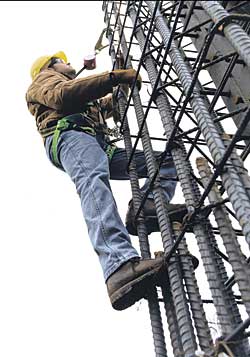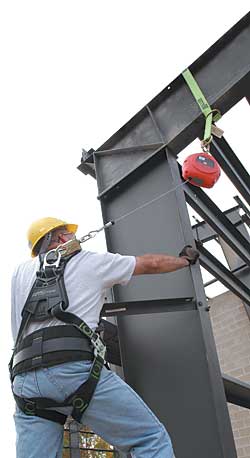
Is Your Equipment A Silent Hazard? Part II: Self-Retracting Lifelines
Historically, harnesses are replaced on the job site more often than connecting devices, even though a connecting device relies on just one strength member.
- By Hugh Smith
- Mar 01, 2007
 ON-THE-JOB injuries cost employers nearly $1 billion per week in payments to injured employees and their medical care providers, according to Boston-based Liberty Mutual, the leading private provider of worker's compensation insurance in the United States. Where do the injuries come from? Falls are one of the leading causes of deaths in the workplace, according to the National Safety Council. Each year, more than 100,000 injuries and deaths are attributable to work-related falls. In addition to permanent injuries and lost lives caused by falls, businesses lose billions of dollars each year from significant increases in insurance premiums, worker's compensation claims, product liability costs, and other related expenses.
ON-THE-JOB injuries cost employers nearly $1 billion per week in payments to injured employees and their medical care providers, according to Boston-based Liberty Mutual, the leading private provider of worker's compensation insurance in the United States. Where do the injuries come from? Falls are one of the leading causes of deaths in the workplace, according to the National Safety Council. Each year, more than 100,000 injuries and deaths are attributable to work-related falls. In addition to permanent injuries and lost lives caused by falls, businesses lose billions of dollars each year from significant increases in insurance premiums, worker's compensation claims, product liability costs, and other related expenses.
Has anyone noticed? Although the manufacture and sales of fall protection products have grown steadily during the past decade, the number of injuries and deaths associated with falls from heights also has increased.
What's the Problem?
Several factors have contributed to these alarming and disturbing statistics:
- All fall protection equipment deteriorates with use and exposure over time, regardless of brand and/or manufacturer.
- Equipment is not inspected often enough for wear and damage.
- Proper training is not provided; often, the wrong equipment is selected for a particular situation, and equipment is not worn properly.
Those specifying or using fall protection equipment know these factors to be valid (at least at some subliminal level). Yet it is very likely that a high percentage of equipment used on job sites throughout North America today would fail to meet safety standards if exposed to a fall. This means someone could be seriously injured or die.
Personal Fall Arrest System
A personal fall arrest system is comprised of three key components: anchorage connector, body wear, and connecting device. While a lot of attention has been given to anchorage connectors and body wear (full-body harnesses) when discussing fall protection, the connecting device (a shock-absorbing lanyard or self-retracting lifeline) between these two components actually bears the greatest fall forces during a fall.
Every component of a personal fall arrest system is vital to worker safety, but the connecting device--and its selection, materials, construction, and inspection/maintenance--is the critical link in assembling a safe fall protection system. Careful consideration and attention must be given before, during, and after a connecting device has been selected.
On a job site, once an anchorage such as an I-beam is located, its strength or its ability to arrest a fall can be determined easily. Choosing the device that connects to the anchorage requires attention because this critical link--the shock-absorbing lanyard or self-retracting lifeline--is comprised of only one strength member (i.e., webbing, rope, steel cable).
In comparison, the full-body harness safely distributes fall forces throughout the chest, shoulders, waist, and legs with many webbing components. In fact, historically, harnesses are replaced on the job site more often than connecting devices, yet a connecting device that relies on one strength member can lead to lanyard/lifeline failure if it exhibits substandard design, poor-quality workmanship, excessive exposure to UV light or chemicals, physical damage, improper storage, or inadequate inspection.
For a worker to safely survive a fall, the connecting device must be carefully inspected and replaced prior to use at the slightest indication of wear or damage.
Self-Retracting Lifelines
Self-retracting lifelines (or SRLs, fall limiters, personal fall limiters, yo-yos, seatbelts, blocks, etc.) are viable alternative connecting devices to shock-absorbing lanyards. While traditional 6-foot shock-absorbing lanyards allow for up to 6 feet of free-fall distance prior to activating and another 3 1/2 feet of deceleration distance prior to arresting a fall, self-retracting lifelines require less than 2 feet to arrest free falls. With the shorter activation distance and shorter overall arresting distance, self-retracting lifelines reduce the risk of hitting the ground or any obstructions at a lower level. In addition, they allow for easier rescue in the event of a fall.
Also, self-retracting lifelines allow for greater horizontal and vertical mobility than standard 6-foot shock-absorbing lanyards. Available with working capacities ranging from 9 feet to 175 feet, self-retracting lifelines should always be used when fall clearance is less than 18 1/2 feet.
Whether using shock-absorbing lanyards or self-retracting lifelines, it is very important to position your anchorage point directly overhead whenever possible. If an anchorage point is not positioned directly overhead and the worker is involved in a fall, a swing fall or pendulum effect will occur while using a shock-absorbing lanyard or self-retracting lifeline.
Inspection and Maintenance
Before every use, inspect the housing of your self-retracting lifeline for loose fasteners and bent, cracked, distorted, worn, malfunctioning, or damaged parts. Test the lifeline retraction and tension by pulling out several feet of the lifeline and allowing it to retract back into the unit. Always maintain a light tension on the lifeline as it retracts. The lifeline should pull out freely and retract all the way back into the unit. Do not use the unit if the lifeline does not retract.
Periodically clean self-retracting lifelines by using a damp cloth and mild detergent, then towel them dry.
What's Needed?
Safety directors and supervisors need to make a concerted effort to keep unsafe and potentially life-threatening equipment out of the hands of those working at heights. Workers, through proper training and attentive daily inspection, will be safer and injury free. Taking equipment out of service too early is a better alternative than explaining to a worker's family that there has been a serious accident.
Some manufacturers have implemented a return-and-inspect program for equipment; ask your supplier for details.
Proper training, maintenance, and inspection of all components of the personal fall arrest system are crucial in creating a safe work environment. Even the highest-quality products require regular inspection, especially when the safety and well-being of the user are at stake.
Once again, remember: Adopt a Smart Policy--when in doubt, throw it out!
This article appeared in the March 2007 issue of Occupational Health & Safety. Part I of this two-part fall protection series ("Is Your Fall Protection Equipment a Silent Hazard?") was published on page 69 of the May 2006 issue of Occupational Health & Safety.
This article originally appeared in the March 2007 issue of Occupational Health & Safety.